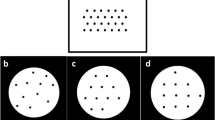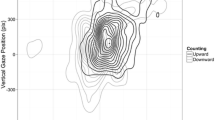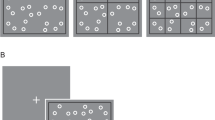Abstract
The mastery of counting numerosities larger than those correctly estimated by infants or non-human species is an important foundation for the development of higher level calculation skills. The cognitive processes involved in counting are related to spatial attention, language, and number processing. However, the respective involvement of language- and/or visuo-spatial-based brain systems during counting is still under debate. In the present functional magnetic resonance imaging study, we asked 27 right-handed participants to perform an enumeration task on visual arrays of bars that varied in numerosity. Each enumeration condition was contrasted to a color-detection condition that was numerically and spatially matched to the counting condition. The results showed a behavioral discontinuity in response time slopes between large (6–10) and small (1–5) numerosities during enumeration, suggesting that during large enumeration, participants engaged counting processes. Comparing brain regional activity during the enumeration of large numerosity to the enumeration of smaller numerosity, we found increased activation in the bilateral fronto-parietal attentional network, the inferior parietal gyri/intraparietal sulci, and the left ventral premotor and left inferior temporal areas. These results indicated that in adults who master enumeration, counting more than five items requires the strong involvement of spatial attention and eye movements, as well as numerical magnitude processes. Counting large numerosity also recruited verbal working memory areas, subtending a subvocal articulatory code and a visual representation of numbers.


Similar content being viewed by others
References
Ansari, D. (2008). Effects of development and enculturation on number representation in the brain. Nature Reviews Neuroscience, 9, 278–291.
Ansari, D., & Karmiloff-Smith, A. (2002). Atypical trajectories of number development: A neuroconstructivist perspective. Trends in Cognitive Sciences, 6, 511–516.
Ansari, D., Lyons, I. M., van Eimeren, L., & Xu, F. (2007). Linking visual attention and number processing in the brain: The role of the temporo-parietal junction in small and large symbolic and nonsymbolic number comparison. Journal of Cognitive Neuroscience, 19, 1845–1853.
Balakrishnan, J. D., & Ashby, F. G. (1992). Subitizing: Magical numbers or mere superstition? Psychological Research, 54, 80–90.
Behrmann, M., Geng, J. J., & Shomstein, S. (2004). Parietal cortex and attention. Current Opinion in Neurobiology, 14, 212–217.
Buccino, G., Binkofski, F., Fink, G. R., Fadiga, L., Fogassi, L., Gallese, V., et al. (2001). Action observation activates premotor and parietal areas in a somatotopic manner: An fMRI study. European Journal of Neuroscience, 13, 400–404.
Connolly, J. D., Goodale, M. A., Menon, R. S., & Munoz, D. P. (2002). Human fMRI evidence for the neural correlates of preparatory set. Nature Neuroscience, 5, 1345–1352.
Corbetta, M., Akbudak, E., Conturo, T. E., Snyder, A. Z., Ollinger, P., Drury, H. A., et al. (1998). A common network of functional areas for attention and eye movements. Neuron, 21, 761–773.
Courtney, S. M., Petit, L., Maisog, J. M., Ungerleider, L. G., & Haxby, J. V. (1998). An area specialized for spatial working memory in human frontal cortex. Science, 279, 1347–1351.
Dehaene, S., Piazza, M., Pinel, P., & Cohen, L. (2003). Three parietal circuits for number processing. Cognitive Neuropsychology, 20, 487–506.
Delazer, M., Domahs, F., Bartha, L., Brenneis, C., Lochy, A., Trieb, T., et al. (2003). Learning complex arithmetic: An fMRI study. Cognitive Brain Research, 18, 76–88.
Delazer, M., Ischebeck, A., Domahs, F., Zamarian, L., Koppelstaetter, F., Siedentopf, C. M., et al. (2005). Learning by strategies and learning by drill—Evidence from an fMRI study. Neuroimage, 25, 838–849.
Duffau, H., Capelle, L., Denvil, D., Gatignol, P., Sichez, N., Lopes, M., et al. (2003). The role of dominant premotor cortex in language: A study using intraoperative functional mapping in awake patients. Neuroimage, 20, 1903–1914.
Fias, W., Lammertyn, J., Reynvoet, B., Dupont, P., & Orban, G. A. (2003). Parietal representation of symbolic and nonsymbolic magnitude. Journal of Cognitive Neuroscience, 15, 47–56.
Fulbright, R. K., Manson, S. C., Skudlarski, P., Lacadie, C. M., & Gore, J. C. (2003). Quantity determination and the distance effect with letters, numbers, and shapes: A functional MR imaging study of number processing. American Journal of Neuroradiology, 24, 193–200.
Gallistel, C. R., & Gelman, R. (1992). Preverbal and verbal counting and computation. Cognition, 44, 43–74.
Geary, D. C. (2000). From infancy to adulthood: The development of numerical abilities. European Child and Adolescent Psychiatry, 9(Suppl. 2), II11–II16.
Geary, D. C., Bailey, D. H., Littlefield, A., Wood, P., Hoard, M. K., & Nugent, L. (2009). First-grade predictors of mathematical learning disability: A latent class trajectory analysis. Cognitive Development, 24, 411–429.
Geary, D. C., Bow-Thomas, C. C., & Yao, Y. (1992). Counting knowledge and skill in cognitive addition: A comparison of normal and mathematically disabled children. Journal of Experimental Child Psychology, 54, 372–391.
Gelman, R., & Gallistel, C. R. (1978). The child’s understanding of number. Cambridge, MA: Harvard University Press.
Horowitz, T. S., & Wolfe, J. M. (1998). Visual search has no memory. Nature, 394, 575–577.
Kansaku, K., Carver, B., Johnson, A., Matsuda, K., Sadato, N., & Hallett, M. (2007). The role of the human ventral premotor cortex in counting successive stimuli. Experimental Brain Research, 178, 339–350.
Kaufman, E. L., & Lord, M. W. (1949). The discrimination of visual number. American Journal of Psychology, 62, 498–525.
LaBar, K. S., Gitelman, D. R., Parrish, T. B., & Mesulam, M. (1999). Neuroanatomic overlap of working memory and spatial attention networks: A functional MRI comparison within subjects. Neuroimage, 10, 695–704.
Landerl, K., Bevan, A., & Butterworth, B. (2004). Developmental dyscalculia and basic numerical capacities: A study of 8–9-year-old students. Cognition, 93, 99–125.
Logie, R. H., & Baddeley, A. D. (1987). Cognitive processes in counting. Journal of Experimental Psychology: Learning, Memory, and Cognition, 13, 310–326.
Mandler, G., & Shebo, B. J. (1982). Subitizing: An analysis of its component processes. Journal of Experimental Psychology: General, 111, 1–22.
Mellet, E., Petit, L., Denis, M., & Tzourio, N. (1998). Reopening the mental imagery debate: Lessons from functional anatomy. Neuroimage, 8, 129–139.
Petit, L., & Beauchamp, M. S. (2003). Neural basis of visually guided head movements studied with fMRI. Journal of Neurophysiology, 89, 2516–2527.
Petit, L., Zago, L., Vigneau, M., Andersson, F., Mazoyer, B., Mellet, E., et al. (2009). Functional asymmetries revealed in visually guided saccades: An fMRI study. Journal of Neurophysiology, 102, 2994–3003.
Piazza, M., Giacomini, E., Le Bihan, D., & Dehaene, S. (2003). Single-trial classification of parallel pre-attentive and serial attentive processes using functional magnetic resonance imaging. Proceedings of the Royal Society of London Series B: Biological Sciences, 270, 1237–1245.
Piazza, M., Mechelli, A., Butterworth, B., & Price, C. J. (2002). Are subitizing and counting implemented as separate or functionally overlapping processes? Neuroimage, 15, 435–446.
Piazza, M., Mechelli, A., Price, C. J., & Butterworth, B. (2006). Exact and approximate judgements of visual and auditory numerosity: An fMRI study. Brain Research, 1106, 177–188.
Pinel, P., Dehaene, S., Riviere, D., & LeBihan, D. (2001). Modulation of parietal activation by semantic distance in a number comparison task. Neuroimage, 14, 1013–1026.
Pinel, P., Piazza, M., Le Bihan, D., & Dehaene, S. (2004). Distributed and overlapping cerebral representations of number, size, and luminance during comparative judgments. Neuron, 41, 983–993.
Price, G. R., Holloway, I., Rasanen, P., Vesterinen, M., & Ansari, D. (2007). Impaired parietal magnitude processing in developmental dyscalculia. Current Biology, 17, R1042–R1043.
Rivera, S. M., Reiss, A. L., Eckert, M. A., & Menon, V. (2005). Developmental changes in mental arithmetic: Evidence for increased functional specialization in the left inferior parietal cortex. Cerebral Cortex, 15, 1779–1790.
Rotzer, S., Kucian, K., Martin, E., von Aster, M., Klaver, P., & Loenneker, T. (2008). Optimized voxel-based morphometry in children with developmental dyscalculia. Neuroimage, 39, 417–422.
Rotzer, S., Loenneker, T., Kucian, K., Martin, E., Klaver, P., & von Aster, M. (2009). Dysfunctional neural network of spatial working memory contributes to developmental dyscalculia. Neuropsychologia, 47, 2859–2865.
Rubinsten, O., & Henik, A. (2009). Developmental dyscalculia: Heterogeneity might not mean different mechanisms. Trends in Cognitive Sciences, 13, 92–99.
Rykhlevskaia, E., Uddin, L. Q., Kondos, L., & Menon, V. (2009). Neuroanatomical correlates of developmental dyscalculia: Combined evidence from morphometry and tractography. Frontiers in Human Neuroscience, 3, 51.
Sathian, K., Simon, T. J., Peterson, S., Patel, G. A., Hoffman, J. M., & Grafton, S. T. (1999). Neural evidence linking visual object enumeration and attention. Journal of Cognitive Neuroscience, 11, 36–51.
Trick, L. M., & Pylyshyn, Z. (1994). Why are small and large numbers enumerated differently? A limited-capacity preattentive stage in vision. Psychological Review, 101, 80–102.
Tzourio-Mazoyer, N., Landeau, B., Papathanassiou, D., Crivello, F., Etard, O., Delcroix, N., et al. (2002). Automated anatomical labeling of activations in SPM using a macroscopic anatomical parcellation of the MNI MRI single-subject brain. Neuroimage, 15, 273–289.
Venkatraman, V., Ansari, D., & Chee, M. W. (2005). Neural correlates of symbolic and non-symbolic arithmetic. Neuropsychologia, 43, 744–753.
Vigneau, M., Jobard, G., Mazoyer, B., & Tzourio-Mazoyer, N. (2005). Word and non-word reading: What role for the Visual Word Form Area? Neuroimage, 27, 694–705.
Wager, T. D., & Smith, E. E. (2003). Neuroimaging studies of working memory: A meta-analysis. Cognitive, Affective & Behavioral Neuroscience, 3, 255–274.
Watson, D. G., Maylor, E. A., & Bruce, L. A. (2007). The role of eye movements in subitizing and counting. Journal of Experimental Psychology: Human Perception and Performance, 33, 1389–1399.
Wojciulik, E., & Kanwisher, N. (1999). The generality of parietal involvement in visual attention. Neuron, 23, 747–764.
Zago, L., Pesenti, M., Mellet, E., Crivello, F., Mazoyer, B., & Tzourio-Mazoyer, N. (2001). Neural correlates of simple and complex mental calculation. Neuroimage, 13, 314–327.
Zago, L., Petit, L., Turbelin, M.-R., Andersson, F., Vigneau, M., & Tzourio-Mazoyer, N. (2008). How verbal and spatial manipulation network contribute to calculation: An fMRI study. Neuropsychologia, 46, 2403–2414.
Author information
Authors and Affiliations
Corresponding author
Rights and permissions
About this article
Cite this article
Zago, L., Petit, L., Mellet, E. et al. Neural correlates of counting large numerosity. ZDM Mathematics Education 42, 569–577 (2010). https://doi.org/10.1007/s11858-010-0254-9
Accepted:
Published:
Issue Date:
DOI: https://doi.org/10.1007/s11858-010-0254-9




